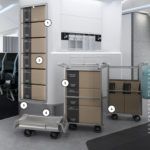Galley design on airplanes has remained broadly unchanged for decades, but AIM Altitude has plans to defy convention.
Aircraft galleys are finally getting the attention they deserve, with a variety of Internet of Things and sensor initiatives from Diehl Aviation, KID-Systeme, Safran Cabin and others coming to the fore. One concept, ARCA, the progeny of AIM Altitude, could shake things up even further – even without an added layer of complex technology.
“Size, proportions and functions of today’s galleys are based on serving individual meal trays out of carts,” says Helena Teichrib, senior industrial designer at AIM Altitude. “With ARCA, we are questioning whether this is still the most efficient way to go about meal service.”
“We are questioning whether serving individual meal trays out of carts is the most efficient way to go about meal service.” – Helena Teichrib, AIM Altitude
ARCA replaces the need to move individual meal trays on to traditional, bulky galley carts with a new packing system: Stored in full-height fridges, the meals – boxed in sets of 16 – are moved in groups onto a cart to be delivered to passengers. By eliminating trays and introducing convertible, collapsible carts that can be used to both serve meals and collect garbage, galley space is dramatically optimized, making room for an extra row of seating or monument.
The design was informed by crew and passenger interviews, as well as consultations with individuals from different areas of airline operations, and findings from past research flights. “This helped us understand what a new system would need to become a real game changer,” Teichrib says. Several stakeholders, particularly catering partners – whose identities are still under wraps – were also involved in the design process: “Their insights really helped us understand how important sustainability has become to airlines today.”
As a result, ARCA was designed to bolster efforts to operate zero-waste flights. “More and more airlines want to recycle and compost the waste that is created during flight, and consumer awareness has strongly increased on that front,” Teichrib says. ARCA’s flexible design is meant to accommodate compostable meal boxes made, for example, from paper or sugarcane bagasse, and the carrier boxes, like the carts, can be repurposed for collecting waste. “This makes separating and stowing different kinds of recyclables easy,” she adds.
A number of other trends also inspired the concept, including an increased appetite for snacks, bento boxes and self-service offerings, as well as the fact that flight distances are getting longer. “As flight times increase, more food needs to be served,” Teichrib says. Therefore, creating space for even more meals on the same or smaller footprint as a traditional galley was a priority.
As airlines grapple with the new challenges associated with in-flight service in the COVID-19 age, Teichrib says that ARCA’s meal pack concept is compatible with the changes ahead. “The enclosed format gives passengers the confidence that a minimum number of people handled the food. “And the sustainable, disposable meal packaging, including the cardboard boxes that all the meals would be delivered in, puts passengers at ease, too.”
“Next on the Menu” was originally published in the 10.3 June/July issue of APEX Experience magazine.




